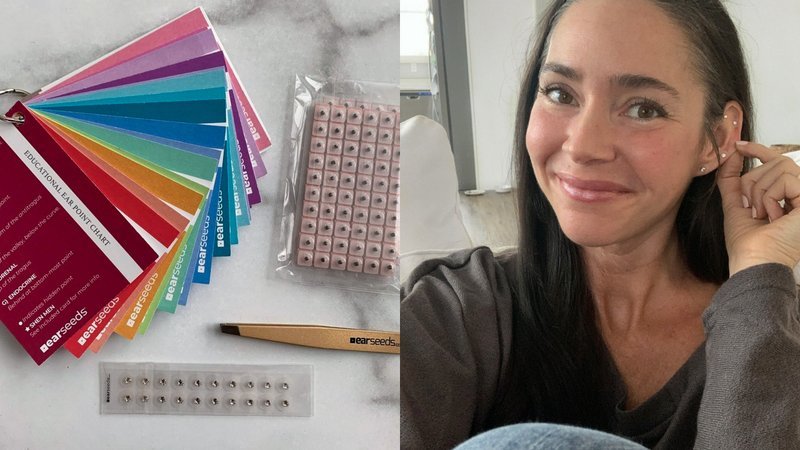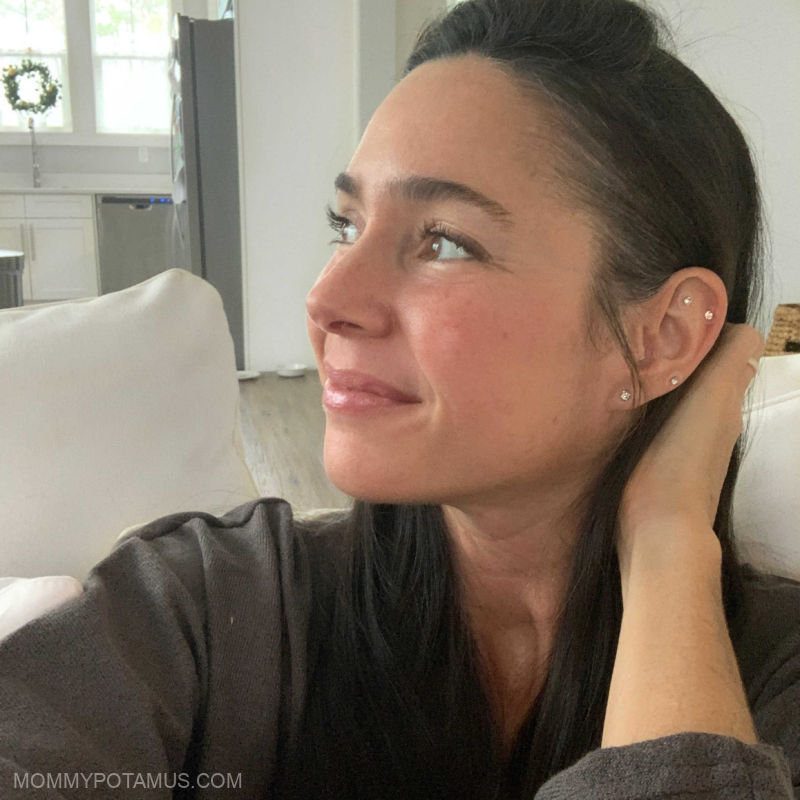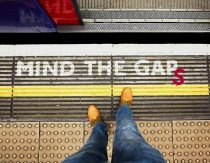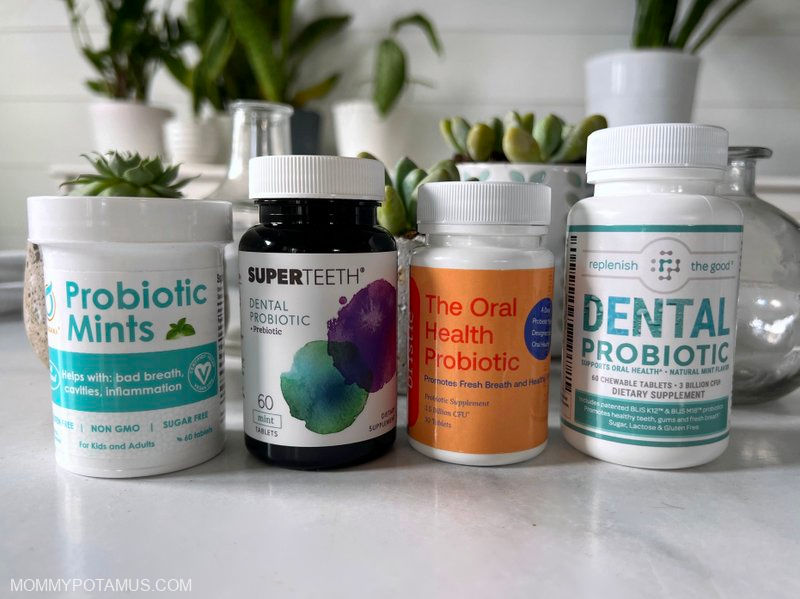
Can an acupressure technique called ear seeding support skin clarity, ease feelings of stress and anxiousness, support focus, deepen sleep and more? According to the acupuncturist who first placed some in my ears several years ago – and my own experience – the answer is yes.
Back then, ear seeds were typically only available in an acupuncturists office, so when I moved to the ocean I stopped using them. Last year, though, I came across ear seeding kits that looked pretty easy to use, and I’m so glad I did.
Before we dive into the details, I want to mention that none of these statements have been evaluated by the FDA, this article is not medical advice, and it is not meant to diagnose or treat any condition. Now that we’ve got that out of the way, you might be wondering . . .
What are ear seeds?
Rooted in Traditional Chinese Medicine (TCM) and the work of a French neurologist named Paul Nogier, ear seeds are a needle-free way to influence our nervous system in ways that – depending on the specific points used – can support a variety of physical and emotional wellness goals.
Known as auriculotherapy, this modality involves placing a small seed on the cartilage of your outer ear and fixing it into place with clear or flesh-colored adhesive. Traditionally the tiny seeds of the flowering Vaccaria herb are used, but other materials like ceramic or metal are also available.
How do ear seeds work?
In Traditional Chinese Medicine, the ear is thought to be a microcosm of the whole body. It contains a variety of acupressure points that are thought to correspond with specific parts of the body.
Exerting gentle pressure on those points is thought to activate them and create a positive influence on the nervous system. It’s similar to ear acupuncture, but instead of intensely stimulating the points with needles for 20-30 minutes, a more gentle form of stimulation happens over a longer period of time – usually 3-5 days.
The customizable kit I bought comes with a set of cards which show where to place ear seeds to support your personal needs/goals. It felt a little intimidating to me at first, but then I learned that there’s a little leeway in where the seeds can be placed.
The pressure points are about ten times larger than the seeds I’m working with, so I don’t have to place the seed in one **exact** teeny tiny spot to support my nervous system. Once I find the general area I’m looking for based on the pictures provided, I gently rub my ear until I find a slightly sensitive spot – that’s where I place the seed.
I’ve found that massaging the seeds a few times a day increases my feelings of relaxation and well-being.

Benefits of Ear Seeds
Cost effective and convenient (since they can be placed at home), ear seeds are believed to support activity of the parasympathetic nervous system, which is the “rest and digest” part of our nervous system that helps us digest food better, think more clearly, respond well to stressful events, and get deep sleep.
Personally, I used to worry that activating the “rest and digest” part of my nervous system instead of the “fight or flight” sympathetic part would make me unproductive, but the opposite is true.
Modern life overstimulates our sympathetic nervous system (fight or flight mode), which leads to burnout and difficulty maintaining motivation. By actively supporting parasympathetic mode (via ear seeds and other methods), I’m able to keep my nervous system more balanced and able to respond to a variety of situations.
In terms of studies, there aren’t a whole lot of high quality ones regarding ear seeds. However, the few studies that do exist suggest benefits. Let’s take a look at some of them:
1. Easing Stress & Feelings of Anxiousness
In one study, researchers found that auriculotherapy (both in the form of ear seeds and semi-permanent needles) was able to decrease stress levels, feelings of anxiousness, and physical discomfort in volunteers who work in a high-stress environment (hospital nursing staff). The study concluded that auriculotherapy in both forms improved quality of life. (1)
On the flipside, patients being transported to the hospital were more calm and optimistic when they received ear acupressure on the way there. (2)
Another study done with stressed out college students divided volunteers into two categories – those who received real auriculotherapy (a mustard seed placed on the Shen Men point and well as a TMJ point) and those who received a sham, non-therapeutic form of auriculotherapy. Those who received the real form experienced a significant reduction in anxiousness, physical discomfort, and electromyographic activity (a measure of tension) compared to the sham group. (3)
2. May Reduce Pain
Several studies have found that ear acupressure can have a positive influence on pain levels, including lower back pain and menstrual discomfort. (4) (5) (6)
Though the exact mechanism is unclear, this study theorizes that it’s probably the same one that research has found for ear acupuncture – the production of natural “feel good” pain relievers called endorphins.
3. May Promote Deeper Sleep
In this analysis of 15 studies, volunteers who received ear seeding therapy showed a positive impact on several markers of sleep quality, including total sleep time, number of awakenings, sleep efficiency, and global score on the Pittsburgh Sleep Quality Index (PSQI).
However, the analysis notes that many of the studies had weaknesses such as very small samples of volunteers, so larger, high quality trials are needed to confirm these effects.
Other Potential Benefits:
Studies suggest that auricular therapy may:
- Benefit the immune system (7)
- Lift mood (8)
- Support focus (9)
- Help optimize metabolic function (10)
Though most of these studies used ear acupuncture instead of acupressure, many practitioners believe that ear seeding has a similar effect. More research is needed to confirm that, plus other potential benefits that have been reported, including:
- Easing motion sickness
- Sinus support during allergy season
- Relaxing forehead tension and more
How To Apply Ear Seeds
1. Clean and dry the outside of your ear (or ears). I typically clean mine with a cotton swab dipped in a little alcohol. Some people just do one ear, and others do both because they feel it amplifies the benefits.
2. Identify your acupressure point(s). My kit came with a set of cards that visually shows where to place the seeds based on the desired effect.
3. Apply ear seed(s). Using the tweezers provided, grab the corner of the adhesive that is attached to the ear seed. Place the sticky side down on the target acupressure point. Gently press the seed to make sure it’s in place. Continue the process until all your ear seeds are in place.
4. Massage the ear seeds 2-3 times per day. Pressing on or massaging the ear seeds a few times per day (or when additional support is needed) is recommended to increase their effect.
5. Remove the ear seeds. Ear seeds often fall off on their own after a few days, but if they’re still in place by the five day mark it’s time to remove them. Lean your head so that your ear is facing the floor – that way, if the ear seed detaches from the adhesive bandage it will fall on the floor instead of into your ear canal. Next, use tweezers or your fingernail to remove the adhesive bandage and seed. It’s best allow the acupressure points to rest a day or two between applications.
Tips:
- Shen men is often called the master point because it is thought to improve the efficacy of all the other points while promoting a sense of well-being, so that’s a good one to start with.
- I’ve applied them on my own, but whenever possible my daughter and I have an “ear seed session” where we place each others. It only takes a few minutes and we get a little bonding/chatting in, too.
Are earseeds safe?
Ear seeds are pretty safe in general, but there are some things to be aware of. Here’s what the company I use – which was founded by acupuncturist Elie Goldschmidt – recommends:
If you are pregnant please consult your doctor before using Ear Seeds.
If skin irritation occurs from the ear seeds, or if swelling should occur, remove the ear seeds immediately and contact your doctor if symptoms persist. The tan tape ear seeds contain latex and should not be used by those with a latex allergy.
Sometimes, when a point is ‘active’ the ear seed will make the ear feel sore, tender and sensitive to touch. This is normal. If discomfort persists you can remove the seeds and reapply at a later time. This discomfort is different than a skin irritation. Read more about ear seed pain here.
On rare occasion, some extremely sensitive people may experience slight nausea or dizziness upon application. This should disappear within the first few minutes after application.
Never place Ear Seeds inside ear canal.
Ear Seeds can be used in conjunction with herbs and other ingestible medications without concern for contraindications.”
Where To Buy Ear Seeds
I like this brand, which as I mentioned above was founded by acupuncturist Elie Goldschmidt. I personally bought their customizable kit with vaccaria seeds, Swarovski crystals, and tweezers but they also have a wide range of options including:
- Kits that address individual goals (scroll down the page to see them all)
- Vaccaria seed kits
- Stainless steel seed kits
- 24K gold and Swarovski crystal kits
Click here to shop their store.
Want more research-backed natural remedies?
No problem, I’ve created a free ebook for you – Kitchen Apothecary: 25+ Natural Remedies Using Ingredients From Your Pantry – as a gift for signing up for my newsletter. You’ll also get updates when I post about safe essential oils for pregnant/breastfeeding mamas, exclusive gifts and coupons (I was able to give away a jar of free coconut oil to anyone who wanted it recently!), plus other goodies.
Sign up using the form below.
Sources
1. Kurebayashi, Leonice Fumiko Sato et. al. (2017) Auriculotherapy to reduce anxiety and pain in nursing professionals: a randomized clinical trial
2. Kober, Alexander et. al. (2003) Auricular Acupressure as a Treatment for Anxiety in Prehospital Transport Settings
3. Hollanda Iunes, Denise et. al. (2015) Role of Auriculotherapy in the Treatment of Temporomandibular Disorders with Anxiety in University Students
4. Priastana, Ketut Andika (2017) A Systematic Review on The Effectiveness of Auricular Acupressure for Pain
5. Yeh, Chao Hsing et. al. (2013) A Randomized Clinical Trial of Auricular Point Acupressure for Chronic Low Back Pain: A Feasibility Study
6. Yeh, Chao Hsing et. al. (2014) Auricular Point Acupressure as an Adjunct Analgesic Treatment for Cancer Patients: A Feasibility Study
7. Hou, Pu-Wei et. al. (2015) The History, Mechanism, and Clinical Application of Auricular Therapy in Traditional Chinese Medicine
8. Tseng, Yen-Ting et. al. (2020) Effects of auricular acupressure on depression and anxiety in older adult residents of long-term care institutions: A randomized clinical trial
9. Binesh, Marzieh et. al. (2020) Comparison of Auricular Therapy with Sham in Children with Attention Deficit/Hyperactivity Disorder: A Randomized Controlled Trial
10. Huang, Ching-Feng et. al. (2019) Auricular acupressure for overweight and obese individuals




